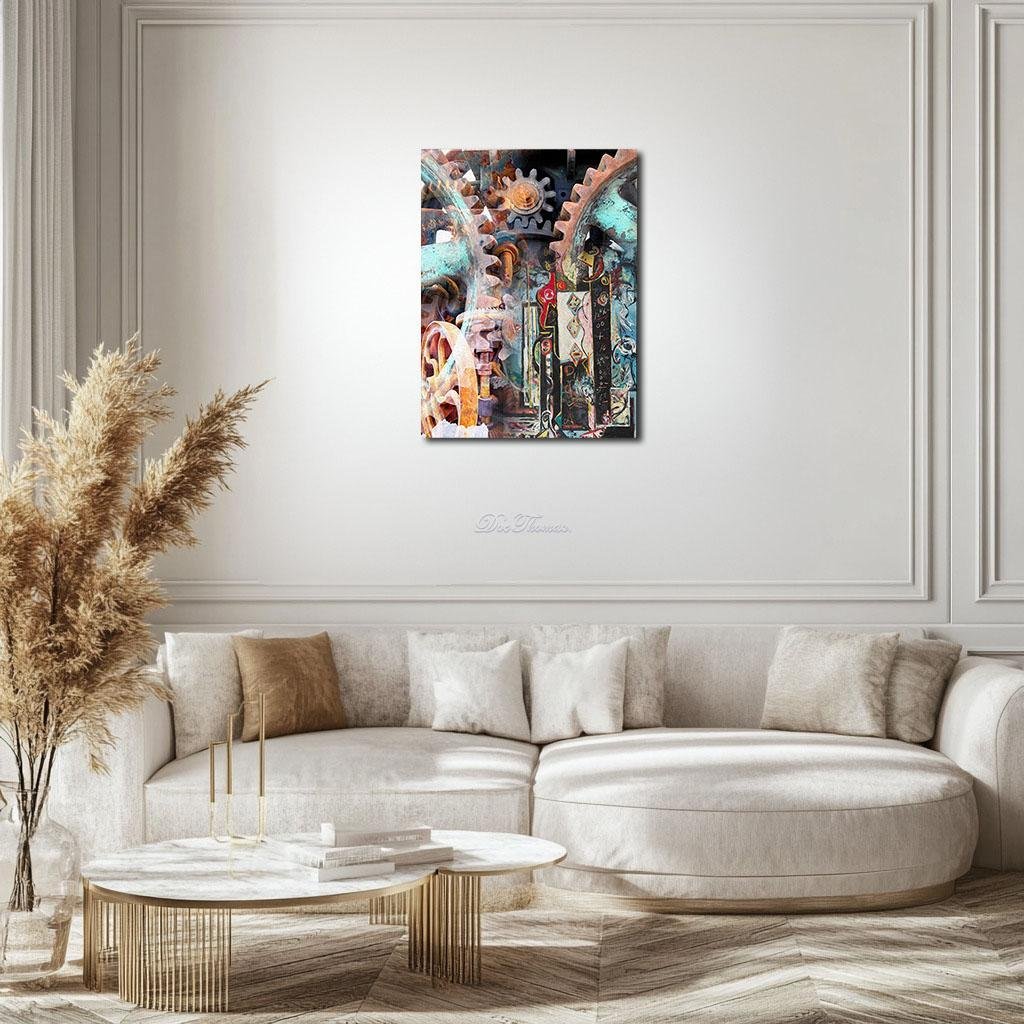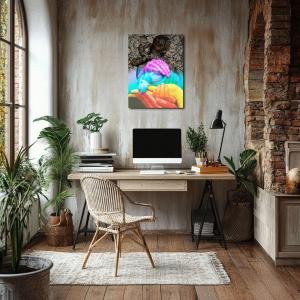Veins of Porcelain: The Cogwheels of Becoming
Veins of Porcelain: The Cogwheels of Becoming fuses Pollock’s Male and Female with the raw mechanics of industrial memory. His iconic figures now reside within a mesh of rusted gears and weathered pistons, transforming symbols of gender into components of a larger system. Oxidized copper, burnt orange, and mechanical black overlay his original palette of carmine, cream, and bold linework. The canvas grinds with tension as identities are pressed, processed, and pulsed into motion. This piece becomes both a blueprint of pressure and a whisper of rebellion—a portrait of what happens when human connection meets machine expectation.
Please see Below for Details…
Hotline Order:
Mon - Fri: 07AM - 06PM
404-872-4663
Veins of Porcelain: The Cogwheels of Becoming reframes Jackson Pollock’s Male and Female within the grinding machinery of psychological time and industrial memory. This surreal reinterpretation merges human archetype and mechanical anatomy, transforming Pollock’s semi-figurative 1942 painting into a complex diagram of desire, thought, identity, and collision. What was once a raw symbolic representation of masculine and feminine dualities is now overlaid with oxidized gears and rusted bolts—symbols of constructed behavior, systemic pattern, and the rigid structures we’re born into.
Pollock’s original forms—his upright totems of male and female—still stand at the center, but now they are trapped within or powering a churning engine. The canvas becomes not only a stage for gender polarity, but also a blueprint of psychic mechanics. The masculine and feminine no longer merely face one another—they are pressed together by the teeth of cold machinery, as if their tension fuels something far larger than personal interaction: the societal machine, the clockwork of repetition.
The palette in this reinterpretation is deeply weathered. Coppery oranges, blistered turquoises, and burnt rust dominate the gear structures. These hues, corroded and alive, hint at entropy and energy in equal measure. Pollock’s original palette—an eccentric blend of jet black, cream white, carmine red, sun-washed ochre, and scratchy pastel pink—still courses through the figures, now cut with machine oil and industrial grit. His original symbols—tall rectangles, lozenges, spirals, numbers, and arrows—are now inscribed onto the gears like inscriptions on ancient alloy, as if the very soul of the machine was etched by unconscious thought.
The gears are layered not just around the forms but within them. One can see pistons blending with Pollock’s vertical streaks, copper rivets mirrored by circular glyphs. The masculine form, with its towering rigidity and numerical markings, appears almost like a lever, a shaft in a larger system. The feminine figure, curvier and fragmented, becomes both conduit and receiver—its spirals mimicking rotating parts. Together, they cease to be individual entities. They become parts of a mechanism—the artist’s, society’s, our own.
Color plays an essential psychological role in this reconstruction. The turquoise on the gears carries the oxidized memory of copper, echoing both decay and time—a symbol of how identity is eroded by expectation. The rust-toned reds mimic coagulated emotion, hardened after too many revolutions of silence. Black, so often used in Pollock as line and boundary, here becomes the grease of survival—slathered across old joins, still keeping things moving. The warm yellows and whites struggle through the shadows like sparks or fleeting joys, never lasting long but refusing to disappear.
As an artist reimagining this work, I saw Male and Female not as a simple dialogue between two bodies, but as a symbolic struggle between freedom and systemization. Pollock’s piece has always spoken in symbols—his numerals, his arrows, his totemic logic—but I wanted to place those symbols inside a mechanism. To suggest that even the most primal aspects of identity—gender, thought, longing—are shaped by unseen gears that grind beneath the surface. We don’t just meet one another as people. We meet as systems. As codes and roles and repetitions.
I envisioned Pollock’s subconscious marks being forced through metal teeth—how the intuitive becomes processed, institutionalized. But I also saw something rebellious in this. The paint leaks through the cracks. His lines curve despite the rigidity. The female form doesn’t collapse—it pulses with molten light. The male figure is not stable—it fractures at its spine. There’s tension, but there’s also motion.
Veins of Porcelain: The Cogwheels of Becoming becomes a meditation on identity as function, on love as machinery, on expression as resistance within constructed roles. It asks what it means to be shaped, stamped, rotated, and reused—and what it means to break the pattern.
Add your review
Your email address will not be published. Required fields are marked *
Please login to write review!
Looks like there are no reviews yet.








